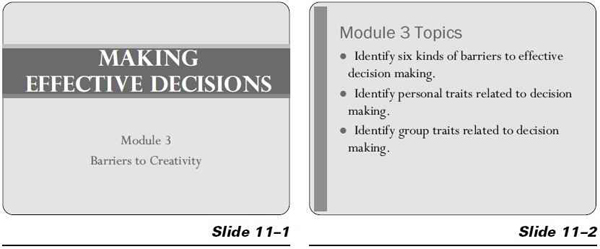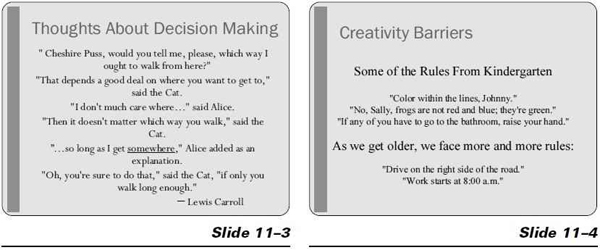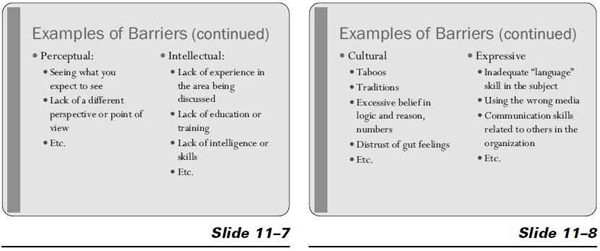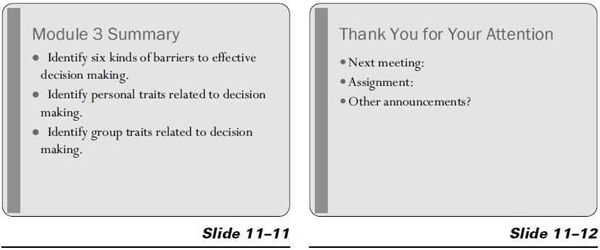C h a p t e r 1 1
Module 3—Barriers
to Creativity
This module elaborates on the subject of the barriers to creativity. Use it in any program that lasts more than one day.
Training Objectives
After completing this module, the participants should be able to identify
- six kinds of barriers that may affect decision making
- personal traits related to decision making
- group traits related to decision making.
 Module 3 Time
Module 3 Time
- Approximately 1 hour
| Introduction, welcome, and review of previous module | 5 minutes |
| PowerPoint presentation | 25 minutes |
| Worksheet exercise | 15 minutes |
| Group discussion of barriers | 10 minutes |
| Wrap-up, learning check, optional worksheet, and preview | 5 minutes |
Note: This includes time for a quick review at the start and a learning check at the end.
Materials
- Attendance list
- Pencils, pens, and paper for each participant
- Whiteboard or flipchart and markers
- Name tags or name tents for each participant
- Worksheet 11–1: Creative Barriers
- Worksheet 11–2: Word Puzzles (optional)
- Computer, screen, and projector for displaying PowerPoint slides; alternatively, overhead projector and overhead transparencies
- PowerPoint slide program (slides 11–1 through 11–12)
- This chapter for reference or detailed facilitator notes
- Optional: music, coffee or other refreshments, selection of puzzles, and brainteasers.
Module Preparation
Arrive ahead of time to greet the participants and make sure materials are available and laid out for the way you want to run the class.
Sample Agenda
| 0:00 | Welcome the class. |
| Have slide 11–1 up on the screen as people arrive; go to slide 11–2 as you begin. | |
| Preview the agenda for this session (the objectives). | |
| Ask for questions or concerns. | |
| 0:05 | PPT Presentation. |
| Begin with slide 11–3; pause for discussion, then proceed through slide 11–8. | |
| 0:30 | Worksheets. |
| Distribute Worksheet 11–1: Creative Barriers. | |
| Show slide 11–9 as participants work on the worksheet. | |
| Move among participants to keep them on task. | |
| Have participants discuss answers with others. | |
| 0:50 | Group discussion. |
| Show slide 11–10 and hold a discussion about the barriers that | |
| participants identified earlier in the session and on their worksheets. | |
| 0:55 | Wrap-up. |
| Show slide 11–11. Review the objectives with participants. | |
| Ask for questions. | |
| Check learning (questions can be oral or printed—see below). | |
| Introduce optional Worksheet 11–2: Word Puzzles. | |
| Show slide 11–12. Dismiss the class. |
Trainer’s Notes
8:00 a.m. Welcome (5 minutes).
![]() Show slide 11–1 as participants arrive.
Show slide 11–1 as participants arrive.
Take care of housekeeping items.
8:05 a.m. Preview the Module Topics (5 minutes).
Show slide 11–2, which provides a preview of the module. Show slide 11–3. Review quotes from Alice in Wonderland.
8:10 a.m. Creativity Barriers (20 minutes).
Show slide 11–4.
Perhaps it was in kindergarten, or certainly by first grade, that you learned that society doesn’t always appreciate creativity. We are taught that we must—to a point—limit our natural childlike tendencies to do things our own way. Although suppressing our urge to do things our own way can be taught in ways that don’t unnecessarily inhibit creativity, the usual pattern is to encourage conformity.
“Color within the lines, Johnny.” “No, Sally, frogs are not red and blue; they’re green.” “If any of you have to go to the bathroom, raise your hand.” (I always wondered how that would help.) As we get older, we face more and more rules:
“Drive on the right side of the road.” “Work starts at 8:00 a.m.” Some rules (such as the one about driving) are obviously necessary for safety or for the functioning of society in an orderly way. Others, however, are not.
The most insidious barriers to creativity are those unnecessary blocks we place on ourselves for a variety of reasons.
Get participants to add their own ideas to the list of barriers to creativity. If the class and company culture permits, you can discuss the creativity barriers that participants encounter in their own workplace. The Dilbert cartoons by Scott Adams usually come up. Keep this process somewhat in check so you don’t go over the scheduled time. Tell people that the main idea here is not to “vent,” but to take these barriers and apply them to James L. Adams’ model. (Adams’ 1974 book Conceptual Blockbusting is the foundation for this list. Although trained as an engineer, Adams became best known for his work in creativity, and he was also a key scientist involved with several NASA missions.)
Also, let participants know that the next module will discuss ways to overcome these barriers.
Show slide 11–5. Go over the six types of barriers to creativity: emotional, environmental, perceptual, intellectual, cultural, and expressive. Then, show slide 11–6.
Emotional Blocks: Examples of emotional blocks include fear, need for security, preference for judging, impatience, and more. An individual who chooses to not try out a new concept may have an emotional block to the concept.
Environmental Blocks: Examples include distractions such as the telephone, email, and chatty colleagues; lack of cooperation from co-workers; autocratic bosses; bureaucracy; things in the workplace that keep you from being creative; and so on. Provide your own examples and ask for examples from the learners.
Work environments are filled with environmental blocks. No single technique works to overcome these, but time management techniques can sometimes reduce them.
Show slide 11–7.
Perceptual Blocks: Mistakes in perceptions include seeing what we expect to see (instead of what’s really there) and not being able to view things differently or from another perspective. Perceptual blocks prevent us from clearly perceiving either the problem itself or accurately seeing information necessary to solve the problem. Too many people spend inadequate time defining the problem. They’re impatient to get on with the “important” part—solving the problem. This can result in a “ready, shoot, aim” tendency.
Take, for example, the manager who has decided that the maintenance department is inept but in reality is blind to the real problem, which is that the equipment is beyond repair.
Intellectual Blocks: Sometimes we simply don’t understand the concepts needed to work on the problem. If you don’t have the experience, academic training, or mental abilities sophisticated enough to understand and deal with the issues surrounding the problem or decision, it’s difficult to be creative. It could also be that you’re locked into a bad approach. Managers who have been promoted from the ranks of workers often find themselves falling behind technologically, especially in fast-changing fields. Their subordinates may understand new and advanced techniques that would work, but the manager may resist using them, fearing loss of control.
Show slide 11–8.
Cultural Blocks: These blocks include taboos; traditions; excessive belief in logic, reason, and numbers; or distrust of fantasy or intuition.
In short, behaving the way we’re “supposed to” means conforming to the normal way of doing things—the opposite of thinking creatively. As will be discussed later in the program, each organization has a unique culture. Conforming to that culture at most times may be essential to getting along in organization, but conforming may also inhibit the implementation of changes that would improve the organization.
Expressive Blocks: Another barrier to creativity arises when a person has inadequate language skill to express and record ideas so he or she can be understood by others. This applies not only to language barriers but also to using the wrong or inappropriate medium to express concepts, such as trying to express a visual idea orally or a mathematical idea in visual terms.
In today’s diverse workplace, managers may find themselves with subordinates and peers who—literally—speak different languages. It takes so much energy for routine communications in these environments that creativity may be reduced.
 8:30 a.m. Creative Barriers Worksheet (20 minutes).
8:30 a.m. Creative Barriers Worksheet (20 minutes).
Distribute Worksheet 11–1: Creativity Barriers.
 Show slide 11–9 as the attendees work on the worksheet. Review the instructions on the PowerPoint slide and on the actual worksheet. Then proceed with the exercise.
Show slide 11–9 as the attendees work on the worksheet. Review the instructions on the PowerPoint slide and on the actual worksheet. Then proceed with the exercise.
INSTRUCTIONS FOR WORKSHEET 11–1: BARRIERS TO CREATIVITY
Objective of the worksheet: This is the third in a series of worksheets. It incorporates one or two topics that were identified in the pretest by participants as decisions they would soon need to make. Each participant will work throughout all the sessions (up to 10, depending on the length of the program) on their personally chosen topics. If the same topic has been chosen by a group, rather than an individual, the worksheet can be completed by one person for the group based on their discussion of the questions.
Time required: Allow approximately 20 minutes for participants to answer the questions.
Instructor guidance: The questions on the worksheet refer to points that were covered in the module 3 presentation, and a summary is included in each box as a memory tool. Walk among the participants during the 20 minutes allowed and try to keep them on task. If some participants finish early, encourage them to work with someone else who is having a problem coming up with answers to write down. If some are not finished by the end of the time, have them continue to think about it and complete the worksheet before the next meeting. Session 4 will build on the answers the participants have recorded on this worksheet.
Wrap-up: At the end of the allotted time, ask the participants to keep the worksheets and bring back for the next session. Return to show the final PowerPoint slide for the module, and ask review questions before dismissing the participants.
8:50 a.m. Traits That Influence Decisions (5 minutes).
Show slide 11–10. Discuss the questions on the PowerPoint slide as a group.
8:55 a.m. Module 3 Summary (5 minutes).
Show slide 11–11. The last two items on this slide were implied in the discussion, and may have come up based on the discussion of the previous slide. Just in case they didn’t, a couple of individual traits would be (1) tolerance for ambiguity and (2) skill in dealing with data (such as statistics). There are many others.
Group traits would include the norms (traditions and informal rules) established by the group, lack of a different perspective, and so on.
 LEARNING CHECK QUESTIONS
LEARNING CHECK QUESTIONS
You can use the learning check questions and answers in oral or printed form.
Discussion Questions
- What are the six types of barriers to creativity?
Answer: emotional, environmental, perceptual, intellectual, cultural, and expressive. - Pick any two of types of blocks, and give an example of how each might affect your decision-making process in selecting a movie to attend. What would you do to guard against these barriers to effective decisions?
Answers will vary from participant to participant.
Multiple Choice Question
- The fear of making a mistake is an example of a _________________ barrier.
a. Emotional (answer)
b. Perceptual
c. Intellectual
d. Environmental
 Instructions for Worksheet 11–2: Word Puzzles (Optional Exercise)
Instructions for Worksheet 11–2: Word Puzzles (Optional Exercise)
Optional exercise: Add 15 minutes.
Objective of this worksheet: Although this worksheet adds some fun to the training session, its real purpose is to demonstrate how the mind causes several of the barriers to creativity that were discussed in the program.
Time required: Allow about five minutes for people to come up with the answers. More than that will frustrate the participants and, unless they’ve seen these before, almost no one ever gets 100 percent of the answers. It will take less than two minutes to give the answers and tie them back to the examples in the session.
Instructor guidance: The answers are included with the worksheet. Do not print that part of the sheet. People may work in groups, if you’ve been doing that, or individually. You might have a small prize for the person who can correctly identify the largest number of anagrams. Be sure to explain at least several of the examples cited in the answer section so that participants can understand the purpose of the exercise and tie it back to the content of the module.
Move among the participants to keep them on task. Discuss with the participants the barriers covered earlier in the class.
Use Worksheet 11–2: Word Puzzles as an optional creative exercise. You can find puzzles like this in a variety of places, from The Reader’s Digest to Internet sites. They’re fun and can be educational (what barriers were responsible for your inability to see the answer right away?), but be aware that the session may extend beyond the budgeted one hour if you go through more than just a few brainteasers.
9:00 a.m. Thank You for Your Attention.
Show slide 11–12. Edit this slide to include information relevant to your class.
Worksheet 11–1
Restate the decision you’re working on:
What are some possible barriers that may prevent you from coming up with options for your sample decision? Mark those that relate to a group and those that relate to an individual.
Emotional. Examples: fear of making mistakes, failing, or taking risks; need for security, order, and structure; preference for judging rather than generating ideas; impatience
|
Environmental. Examples: distractions such as the telephone, emails, and chatty colleagues; lack of cooperation from co-workers; autocratic bosses; bureaucracy
|
Perceptual. Examples: seeing what we expect to see, not being able to view things differently, spending inadequate time defining the problem to get on with the “important” part of solving it
|
Intellectual. Examples: inexperience, lack of academic training or mental abilities sophisticated enough to understand and deal with the issues surrounding the problem or decision, being locked into a bad approach
|
Cultural. Examples: taboos, traditions, excessive belief in logic, reason, numbers; distrust of fantasy, intuition, and different drummers; in short, behaving the way we’re “supposed to” is conforming, not creative
|
Expressive. Examples: inadequate language skill to express and record ideas in a manner that can be understood by others, or using the wrong or inappropriate medium to express concepts, such as trying to express a visual idea orally or a mathematical idea in visual terms
|
Notes:
© 2010 Decision-Making Training, American Society for Training & Development
Worksheet 11–2
Each of the following squares contains a word puzzle that can be read as a common phrase or saying. How many of them can you get? Which barriers to creativity may be operating to keep you from seeing them at first?
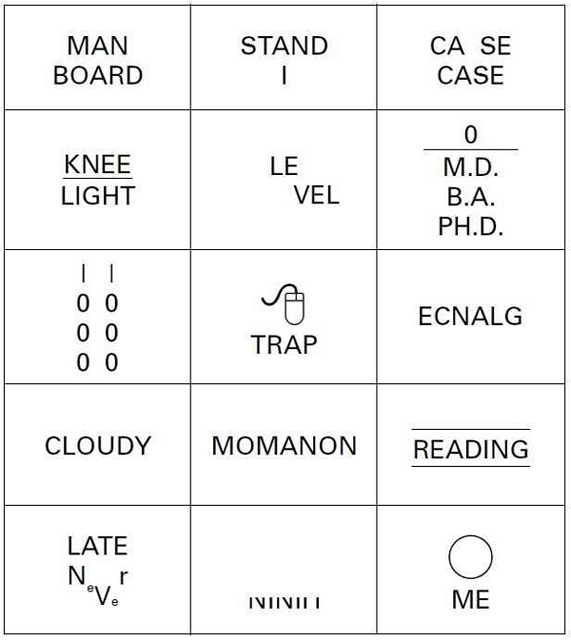
Answers:
First row: Man Overboard
I Understand (Most people start out trying “stand on I” or “stand on 1.” They use what worked in the first box.)
Open and shut case
Second row: Neon light (This is different from the first two boxes because it requires conjoining the first word and the preposition to make a different word. Again, the pattern that worked before must be altered.)
Split level (or bi-level)
Three degrees below zero
Third row: Circles under the eyes
Mouse trap
Backwards glance
Fourth row: Partly (or mostly) cloudy
Man in the moon
Reading between the lines
Fifth row: Better late than never
Bottom half of the ninth
A round on me (which you might be ready for by now)
© 2010 Decision-Making Training, American Society for Training & Development
